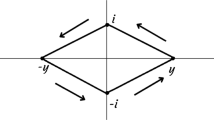Abstract
We show that Thompson’s \(A\times B\)-lemma can be obtained as a consequence of Brauer’s third main theorem.
Similar content being viewed by others
Avoid common mistakes on your manuscript.
Let k be an algebraically closed field of prime characteristic p. Brauer’s third main theorem [2, Theorem 3], rephrased using Brauer pairs (cf. [1, Theorem 3.13] or [7, Theorem 6.3.14], or also [5, Theorem 7] for a different proof), states that if b is the principal block idempotent of a finite group algebra kG, then \(\mathrm {Br}_Q(b)\) is the principal block idempotent of \(kC_G(Q)\) for any p-subgroup Q of G. Here \(\mathrm {Br}_Q : (kG)^Q\rightarrow kC_G(Q)\) denotes the Brauer homomorphism (cf. [3, §1.2] or [6, Theorem 5.4.1]). In particular, if kG has a unique block, then \(kC_G(Q)\) has a unique block. Moreover, if kG has a unique block, then \(O_{p'}(G)=1\) because otherwise \(\frac{1}{|O_{p'}(G)|} \sum _{g \in O_{p'}(G)} g\) would be a central idempotent in kG different from 1. Also, it is well-known that if G has a self-centralising normal p-subgroup, then kG has a unique block (cf. [7, Corollary 6.2.8]). We use these facts to give a proof of the following result.
(Thompson’s \(A \times B\)-lemma; cf. [4, Chapter 5, Theorem 3.4]). Let \(A \times B\) be a subgroup of the automorphism group of a finite p-group P, with A a \(p'\)-group and B a p-group. If A acts trivially on \(C_P(B)\), then \(A=1\).
FormalPara ProofConsider the group \(G=P \rtimes (A\times B)\), where the notation is as in the statement, and suppose that A acts trivially on \(C_P(B)\). Note that \(S=P\rtimes B\) is the unique Sylow p-subgroup of G, and that A can be regarded as a \(p'\)-subgroup of the automorphism group of S. Thus S is self-centralising and normal in G, and hence kG has a unique block.
By the assumptions, A acts trivially on the group \(Q = C_P(B) \times B\). That is, we have \(A \le C_G(Q)\), and hence \(C_G(Q) = C_S(Q) \rtimes A\). Since kG has a unique block, \(kC_G(Q)\) has a unique block. We now show that Q is self-centralising in S. Let \(x\in C_S(Q)\). Write \(x = yu\) for some \(y\in P\) and \(u\in B\). Since \(u\in B\), it follows that conjugation by u preserves the decomposition \(Q = C_P(B) \times B\). Thus conjugation by y preserves this decomposition as well. In particular, y normalises B. By elementary group theory, it follows that y centralises B. Indeed, if \(u\in \) B, then \(yuy^{-1}u^{-1} \in P \cap B =1 \). This shows that \(C_S(Q) \le Q \). Since \(Q \le C_G(A)\), it follows that \(C_G(Q) = C_S(Q) \times A\). By the above, \(kC_G(Q)\) has a single block, and hence \(A=O_{p'}(C_G(Q))=1\). \(\square \)
References
Alperin, J.L., Broué, M.: Local methods in block theory. Ann. Math. 110, 143–157 (1979)
Brauer, R.: Some applications of the theory of blocks of characters of finite groups I. J. Algebra 1, 152–167 (1964)
Broué, M.: Brauer coefficients of \(p\)-subgroups associated with a \(p\)-block of a finite group. J. Algebra 56, 365–383 (1979)
Gorenstein, D.: Finite Groups. Chelsea Publishing Company, New York (1980)
Külshammer, B.: The principal block idempotent. Arch. Math. (Basel) 56, 313–319 (1991)
Linckelmann, M.: The Block Theory of Finite Group Algebras I. London Mathematical Society Student Texts, vol. 91. Cambridge University Press, Cambridge (2018)
Linckelmann, M.: The Block Theory of Finite Group Algebras II. London Mathematical Society Student Texts, vol. 92. Cambridge University Press, Cambridge (2018)
Acknowledgements
The authors would like to thank G.R. Robinson for helpful comments on an earlier version of this note. The first author acknowledges support from EPSRC Grant EP/T004592/1.
Author information
Authors and Affiliations
Corresponding author
Additional information
Publisher's Note
Springer Nature remains neutral with regard to jurisdictional claims in published maps and institutional affiliations.
Rights and permissions
Open Access This article is licensed under a Creative Commons Attribution 4.0 International License, which permits use, sharing, adaptation, distribution and reproduction in any medium or format, as long as you give appropriate credit to the original author(s) and the source, provide a link to the Creative Commons licence, and indicate if changes were made. The images or other third party material in this article are included in the article’s Creative Commons licence, unless indicated otherwise in a credit line to the material. If material is not included in the article’s Creative Commons licence and your intended use is not permitted by statutory regulation or exceeds the permitted use, you will need to obtain permission directly from the copyright holder. To view a copy of this licence, visit http://creativecommons.org/licenses/by/4.0/.
About this article
Cite this article
Kessar, R., Linckelmann, M. A block theoretic proof of Thompson’s \(A\times B\)-lemma. Arch. Math. 117, 481–483 (2021). https://doi.org/10.1007/s00013-021-01638-5
Received:
Accepted:
Published:
Issue Date:
DOI: https://doi.org/10.1007/s00013-021-01638-5




